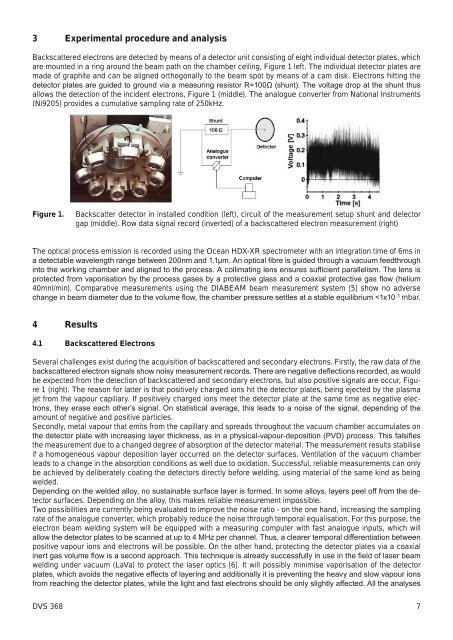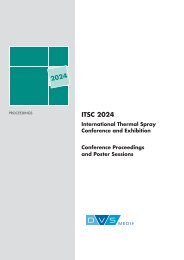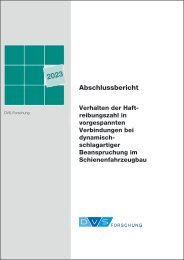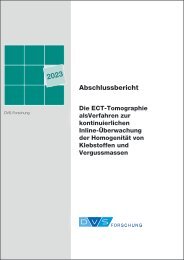Create successful ePaper yourself
Turn your PDF publications into a flip-book with our unique Google optimized e-Paper software.
3 Experimental procedure and analysis<br />
Backscattered electrons are detected by means of a detector unit consisting of eight individual detector plates, which<br />
are mounted in a ring around the beam path on the chamber ceiling, Figure 1 left. The individual detector plates are<br />
made of graphite and can be aligned orthogonally to the beam spot by means of a cam disk. Electrons hitting the<br />
etector late are ie to ron via a earin reitor nt e voltae ro at te nt t<br />
allows the detection of the incident electrons, Figure 1 (middle). The analogue converter from National Instruments<br />
(Ni9205) provides a cumulative sampling rate of 250kHz.<br />
Figure 1.<br />
Backscatter detector in installed condition (left), circuit of the measurement setup shunt and detector<br />
gap (middle), Row data signal record (inverted) of a backscattered electron measurement (right)<br />
The optical process emission is recorded using the Ocean HDX-XR spectrometer with an integration time of 6ms in<br />
a etectale avelent rane eteen n an n otical re i ie tro a vac feetro<br />
into te orin caer an aline to te roce colliatin len enre cient aralleli e len i<br />
rotecte fro vaoriation y te roce ae y a rotective la an a coaial rotective a o eli<br />
40mnl/min). Comparative measurements using the DIABEAM beam measurement system [5] show no adverse<br />
cane in ea iaeter e to te vole o te caer rere ettle at a tale eiliri -3 mbar.<br />
4 Results<br />
4.1 Backscattered Electrons<br />
Several challenges exist during the acquisition of backscattered and secondary electrons. Firstly, the raw data of the<br />
accattere electron inal o noiy eareent recor ere are neative eection recore a ol<br />
be expected from the detection of backscattered and secondary electrons, but also positive signals are occur, Figure<br />
1 (right). The reason for latter is that positively charged ions hit the detector plates, being ejected by the plasma<br />
jet from the vapour capillary. If positively charged ions meet the detector plate at the same time as negative electron<br />
tey erae eac oter inal n tatitical averae ti lea to a noie of te inal eenin of te<br />
amount of negative and positive particles.<br />
Secondly, metal vapour that emits from the capillary and spreads throughout the vacuum chamber accumulates on<br />
te etector late it increain layer ticne a in a yicalvaoreoition roce i falie<br />
the measurement due to a changed degree of absorption of the detector material. The measurement results stabilise<br />
if a homogeneous vapour deposition layer occurred on the detector surfaces. Ventilation of the vacuum chamber<br />
leads to a change in the absorption conditions as well due to oxidation. Successful, reliable measurements can only<br />
be achieved by deliberately coating the detectors directly before welding, using material of the same kind as being<br />
welded.<br />
eenin on te ele alloy no tainale rface layer i fore n oe alloy layer eel o fro te etector<br />
surfaces. Depending on the alloy, this makes reliable measurement impossible.<br />
Two possibilities are currently being evaluated to improve the noise ratio - on the one hand, increasing the sampling<br />
rate of the analogue converter, which probably reduce the noise through temporal equalisation. For this purpose, the<br />
electron beam welding system will be equipped with a measuring computer with fast analogue inputs, which will<br />
allo te etector late to e canne at to er cannel a clearer teoral ierentiation eteen<br />
positive vapour ions and electrons will be possible. On the other hand, protecting the detector plates via a coaxial<br />
inert a vole o i a econ aroac i tecnie i alreay cceflly in e in te el of laer ea<br />
welding under vacuum (LaVa) to protect the laser optics [6]. It will possibly minimise vaporisation of the detector<br />
late ic avoi te neative eect of layerin an aitionally it i reventin te eavy an lo vaor ion<br />
fro reacin te etector late ile te lit an fat electron ol e only litly aecte ll te analye<br />
<strong>DVS</strong> <strong>368</strong> 7


















